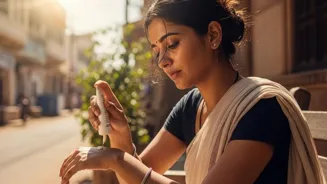In India, the average skincare routine may include a moisturiser, a face wash, and maybe a serum. But sunscreen? For most Indians, sunscreen remains a cosmetic add-on, something associated with beach vacations
or hot summers—not a daily health essential. This mindset needs urgent change, because science tells a different story.
Studies and dermatologists advocate that sunscreen isn’t cosmetic—it’s preventive care. Multiple rigorous scientific studies have established that regular sunscreen use is one of the most effective ways to prevent skin cancer and premature skin ageing.
What Does Data Tell Us?
The landmark Nambour trial in Australia, one of the largest and longest-running randomised controlled trials on this subject, demonstrated that daily sunscreen use resulted in a 40 per cent reduction in squamous cell carcinoma and, more strikingly, a 73 per cent reduction in invasive melanoma over long-term follow-up.
Another systematic review published in 2024 reaffirms these findings, showing strong evidence for sunscreen’s role in reducing the risk of both melanoma and actinic keratoses (precancerous skin lesions). And it’s not just about cancer—daily application also significantly slows visible photoaging, as proven in a nested Nambour trial that found 24 per cent less skin ageing among sunscreen users.
In Canada, more than 80,000 cases of skin cancer are diagnosed every year, according to the Canadian Medical Association Journal. Because exposure to ultraviolet radiation is estimated to be associated with 80–90 per cent of skin cancers, the use of sunscreen — which blocks ultraviolet radiation — is promoted as an important means of preventing skin cancers as well as sunburn and skin photoaging.
“Exposure to ultraviolet radiation is directly harmful and has been associated with the development of skin cancers, which are common in Canada. High-quality evidence has shown that sunscreen reduces the risk of developing both melanoma and nonmelanoma skin cancer,” said the Canadian study titled The efficacy and safety of sunscreen use for the prevention of skin cancer.
Yet here in India, sunscreen is still misunderstood, underused, and often skipped altogether. While we can argue that people with brown or dark skin have a lower rate of skin cancer, experts believe that when they do get it, it’s often diagnosed late and at a more aggressive stage.
What Is Sunscreen Lotion & How To Apply It?
According to Dr Deepali Bhardwaj, a popular dermatologist based in South Delhi, there’s a growing trend where women and girls are heavily influenced by social media beauty content. “Many now follow the advice of influencers when choosing skincare products, particularly sunscreens. Expensive international products—especially Korean skincare brands—are highly coveted, and many consumers judge them by price or packaging rather than clinical relevance.”
One of the most common misconceptions is that the higher the Sun Protection Factor (SPF), the better the protection. But this is not entirely correct. SPF primarily measures protection against UVB rays, not UVA or other forms of light damage. Beyond SPF, what really matters is whether the sunscreen offers broad-spectrum protection.
“A well-formulated sunscreen should include both physical and chemical blockers—ingredients that protect against UVA, UVB, High Energy Visible Light (HEVL), and blue light. These four components of solar radiation are all capable of damaging the skin, each in a slightly different way,” Bhardwaj explained.
UVA rays penetrate deeply and are mainly responsible for skin ageing and long-term cellular damage, whereas UVB rays affect the surface layers of the skin and are the primary cause of sunburn and direct DNA mutations leading to skin cancer. HEVL, the visible portion of sunlight, is increasingly recognised for contributing to pigmentation, inflammation, and oxidative stress. Also, blue light, emitted from device screens and LED lighting, may accelerate ageing and hyperpigmentation, especially in darker skin tones.
Most people don’t realise that the sunlight spectrum includes more than just ultraviolet rays. It consists of UV light, visible light (including HEVL), and infrared light—all of which can impact skin health.
“For Indian skin, an SPF of 25 or above is typically sufficient, provided the sunscreen has broad-spectrum coverage. Application technique matters just as much as the product itself,” Bhardwaj said while explaining how to apply. One simple way to measure the right amount is the “finger rule”: one finger has three phalanges (boxes), so applying one and a half fingers’ worth of sunscreen is a good guide for the face and neck.
“It’s crucial to apply sunscreen 15 minutes before sun exposure, and to reapply every three hours for continued protection—especially if you’re sweating, in sunlight, or near windows.”
Myths That Stop Indians From Using Sunscreen
According to Dr Anil KV Minz, senior consultant-dermatology at Marengo Asia Hospitals, Faridabad, misinformation and lack of awareness continue to fuel poor sunscreen habits.
“Generally, I get to hear from patients that they are not in the sun, it’s not summer, or they’ve read online that sunscreen causes cancer. All of these are misconceptions. Even indoors, we are exposed to UV light through windows and LED screens. Sunscreens have been used for decades by millions without a proven increase in cancer. The formulations have also advanced dramatically—gels, sprays, powders, and creams now cater to nearly every skin type and lifestyle.”
Also, Indians have long harboured the myth that sunscreen is only important for women, not men.
“There’s a deeply ingrained belief that skincare, especially sun protection, is a feminine concern,” Bhardwaj said. “In my 15 years of experience, I have seen how many in India assume that people who apply sunscreen are doing so to become fairer, not to protect their skin. This perception is especially common among men, who often dismiss sunscreen as unnecessary or even un-masculine.”
According to a review published in the Journal of Integrative Dermatology in 2024, “while sunscreen is well-established to prevent skin cancer, public use and adherence remain low. Studies show 14.3 per cent of men and 29.9 per cent of women regularly use sunscreen on both their face and exposed areas”.
What Needs to Change
Sunscreen should be framed like brushing your teeth or wearing a seatbelt—non-negotiable daily habits that prevent long-term harm. It’s time to move beyond anecdotal beliefs and follow the evidence. For a country exposed to harsh sunlight year-round, the science is clear: sunscreen is not a luxury—it’s protection against ageing, pigmentation, even-toned skin and cancer.










